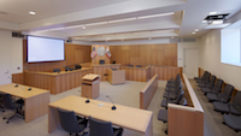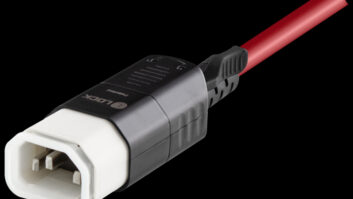
Courthouse Audio, Part 1
Aug 26, 2014 7:21 PM,
With Bennett Liles
Listen to the Podcasts

Editor’s note: For your convenience, this transcription of the podcast includes timestamps. If you are listening to the podcast and reading its accompanying transcription, you can use the timestamps to jump to any part of the audio podcast by simply dragging the slider on the podcast to the time indicated in the transcription.
From Sound & Video Contractor Magazine, this is the SVC Podcast show 112 part 1 with Bobby Harper of ACIR Professional. Show notes for the podcast are available on the web site of Sound & Video Contractor Magazine at svconline.com.
The Evesham, New Jersey courthouse had an old sound layout that wasn’t working for them so they called in ACIR Professional of Mays Landing to design and install a whole new system. That new one is based on the Yamaha MTX5-D processor and Bobby is here to give us the lowdown on how their new sound setup works. That’s coming up next on the SVC Podcast.
Bobby, thanks for being here with us on the SVC Podcast from ACIR Professional in Mays Landing, New Jersey. You did a complete sound system renovation at the Evesham, New Jersey courthouse and we haven’t looked at a courthouse installation in a while so this one looked interesting. So what’s been happening at ACIR Professional? What sort of projects do you get into there?
We’ve been very busy this year. What we are typically is a large production house. We do a lot of rentals of audio, lighting, video and backline for live concerts, and about three years ago I started the sales and install division. And it’s picked up; it’s gotten very busy. We’ve done a lot of different types of sales and install projects. And for a production house, typically during November, December, January, February, March it usually gets a little slow, and this year has just been crazy. Our calendar hasn’t dropped off at all, so it’s a good thing. We’re a growing company and the sales division is also growing and we do projects ranging from churches to theaters and now courtrooms. [Timestamp: 2:02]
Yeah, in the AV installation business you never know exactly what may come in the door and I think they use this place for more than just a courtroom.
Yes, it’s a municipal court which is typically a non-jury courtroom and they also – nowadays, most of your municipal courts hold all their town meetings in there and other special events. They’ll do weddings in there if they can make money. I mean it’s where it’s all about is keeping the revenue flowing. But yeah, this is – mainly it’s a courtroom, yes. [Timestamp: 2:32]
What kind of a sound system did they have and how were they using it before your guys got in there and did the upgrade? How did the old one work?
It was older technology speakers, older technology design. All the speakers were on one equalizer and one channel of an amplifier and they had 16 Shure MX Series microphones, which are really great microphones, going through this one channel. You know, it didn’t sound good to begin with and then on top of that they would have one line go bad. They had a multitrack interface, a device to capture sound from the output of their existing processor to the computer, a channel had went down and they didn’t know it and I didn’t know because I really didn’t troubleshoot the system. I just – you know, I went in there and they told me what they were looking to do and they wanted to replace everything and we ended up replacing everything, including the microphones, which some of them were bad and half of them were still good. I switched from an MX12 to MX18, which gives them a little more proximity to the microphone, so the sound right off the bat is gonna sound a little better right from the get-go. [Timestamp: 3:49]
When those systems have been in place for a good while they tend to get little things added here and there and it can eventually grow into kind of a monster I guess. You decided to base this system on the Yamaha MTX5-D processor. What was the attraction with that particular one?
This is a real new Yamaha product and I’ve bid on a few municipal courts and I didn’t get the jobs and I’m not sure if it was I was overpriced or what, but I was just always steering away from that type of work. All the manufacturers – you had to buy speakers from one manufacturer and an amplifier from another and a signal processor from another, the microphones from another. This Yamaha CIS with their install solution, they supply everything except the microphones; it’s the amplifier, the processor, the mic tray amps, the Dugan card if you want one installed in it. And when they came in to demo it to ACIR – we’re a fairly large Yamaha dealer – when they came in and showed me this product, right off the bat I was really excited because it’s one-stop shopping. I liked what they were saying. The speakers, it turns out they just sound wonderful. They’re very cost effective and the install per speaker can vary, but with most other manufacturers it’s about 20 percent quicker per speaker So it ends up saving you a lot of time. The more speakers you have the more time you save. [Timestamp: 5:23]
And no compatibility problems.
None whatsoever. Something I really liked about the processer was – well, a couple things, but the one thing is the GUI of the interface when you’re looking at the software of the processer on a laptop, it looks like a mixing console. So if you’re a real, live audio mixer and you have to go into an AV situation that you’re not used to and you go into this interface and look at it, it’s like you’re looking at a mixing console with sends on faders. So if you have different zones, it’s just like you’re mixing monitors. You hit send on fader, you hit zone one and you bring up the faders that you want in that zone. So I really like that about it, and then the fact that you can insert different cards into the processor; courtrooms and whatnot are always installing automixers of one type or another and I went with the Dugan automixer card that inserts right into the processer and it does 16-channel automixing for you. It really does work well. I was really impressed with it. [Timestamp: 6:31]
Yeah, if you’re doing automixing I guess you can’t go wrong with Dugan since he actually invented the whole automixing thing.
That’s the way I looked at it too. I’ve sold a lot of Dugan cards. I wasn’t real fluent with the whole process. I had to do – there was a learning curve on how it actually operated, but there’s no learning curve once you plug it in. It’s truly plug-and-play and once it’s in there you can go through an Ethernet cable into your laptop and have a separate window open and you can watch the Dugan card do its thing. And it’s just amazing how quick – there’s zero latency, zero noise and it really does what it says it’s going to do. And that really helped the whole situation a lot. [Timestamp: 7:19]
And of course the Yamaha MTX5-D is an eight channel unit and you had 16 microphones so you also used I believe, the EXi8?
Yeah, that’s an eight-channel extender and that just connects with a Ethernet cable via the YDIF, which is a Yamaha proprietary digital transmission.
And all of that only takes up something like three rack spaces.
Well, let see. What I had was one, two then I had two more rack spaces of amplifier.
And the Yamaha input extender is just a single rack space I think.
Yeah, so that’s three and two more for the amplifier.
Yeah, pretty compact for all it does.
Yeah, I’d say so. I’d say so.
So you programmed this to set up a four-zone mix minus. How did that work for them?
When we first came in there and listened to the existing system, 16 microphones were open at one time going through one third octave EQ into every speaker. And there were speakers over the top of the judge, there were speakers over the top of the prosecutor, over the defendant, over the witness. And I mean you could have done it that way with a lot of EQ and maybe newer mics and blah, blah, blah and it could have worked, but it really was not working well at all. And what I decided to do was when I talked into the judge’s mic on the existing system, it really sounded bad but I could hear myself coming from the other speakers. So I figured if I just did a mix minus, the amplifier is a four-zone amplifiers – four channels. So I did a gallery output, which is all the audience, you know, like 12 speakers there. I did a prosecutor, a defendant and then two speakers in another zone; one’s for the witness and one’s for the judge. So it’s four zones and by mix minus, what I mean is the judge – she has everything in her mix minus herself.
Mm-hmm.
And the prosecutor has everything in his mix minus himself. You’re not in an arena, you’re in a very small courtroom with good ambient noise so you can hear yourself talk and you can also hear yourself in the speakers which were like 10 feet away if there wasn’t one directly over your head. So it really made a lot of sense. It worked well. I could get a lot of gain before feedback and the clarity – there was no tonal degradation at all. And these Yamaha speakers, they sound really good. [Timestamp: 9:58]
Where have you got all the gear in the racks?
Fortunately, there’s a wall right behind the dais where you have the judge and on their side of the judge you have the dais, which people were never there while the judge is there. They use that for the community town meetings and whatnot. So behind them is a wall and the amp rack is right behind that wall. Unfortunately, the floor that that dais is on is all concrete, so that was a little bit of a problem. I didn’t want to have to run all new cabling, which I used all existing cabling. I doubled upon some to get some things happening, which I needed to. There were a few extra lines already run and it worked really well. But the controller for the preset, I couldn’t put right at the clerk because I couldn’t get an Ethernet cable to her, so I had to put it on the wall behind her. They loved it. They’re fine with it. All she does is turn around when she walks in. It’s never touched except for when they first come in. There’s two presets, one for court and one for meetings. If it’s court, it turns off all the dais mics and turns on all the other mics. If you hit meetings it turns on all the mics. [Timestamp: 11:17]
Keep it simple and reliable.
Yeah, exactly. So that part worked out real well.
Sounds like an interesting setup. In a courtroom it’s going to be a fairly quiet environment with only one person talking in a pretty structured format so any static, feedback or switching noise is really going to get noticed so it sounds like they got what they needed. Thanks for telling us about it, Bobby. Bobby Harper from ACIR Professional in Mays Landing, New Jersey and in part two we’ll get into the speaker installation and the system testing so we’ll see you then.
All right. My pleasure.
Thanks for being here with us for the SVC Podcast with Bobby Harper of ACIR Professional. Show notes for the podcast are available on the website of Sound & Video Contractor Magazine at svconline.com. In part two Bobby will tell us about the speaker installation and system testing at the Evesham courthouse next time on the SVC Podcast.








